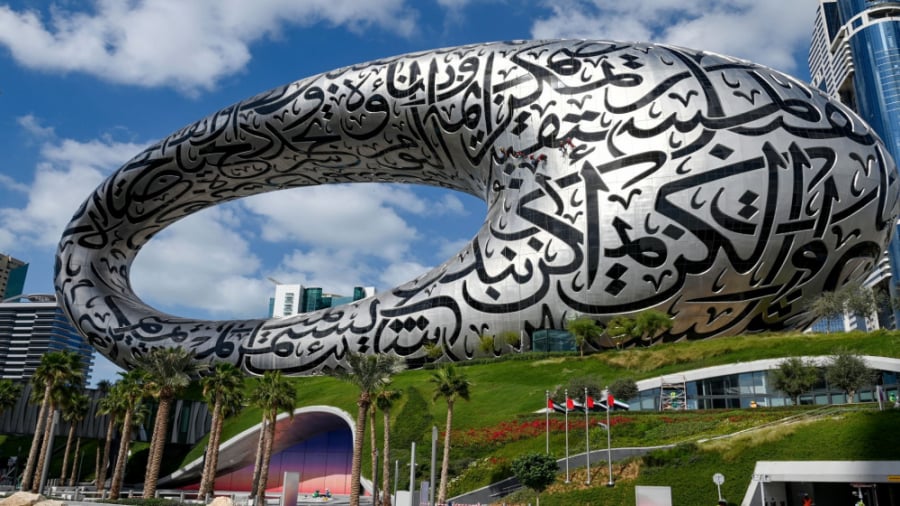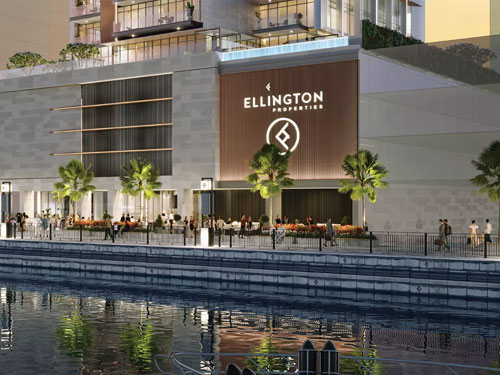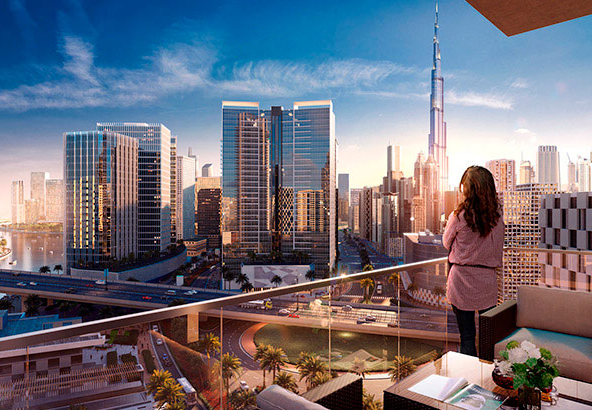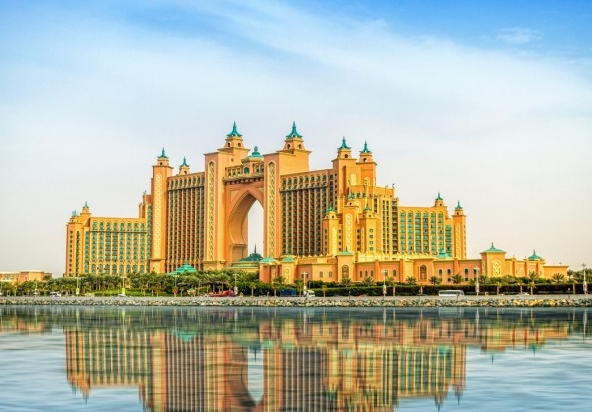The Museum of the Future in Dubai is one of the most famous and innovative tourist and cultural attractions in Dubai, which opened on February 22, 2022. This museum was designed and built as a symbol of technological advancements and innovation in the future. Here is a comprehensive description of this museum:
Everything About the Museum of the Future in Dubai:
Location and Design
The Museum of the Future in Dubai is one of the most captivating and advanced architectural and cultural attractions in the city. Its design is crafted in such a way that it transports visitors to the world of tomorrow. The museum is located in the Burj Khalifa area, near the Burj Khalifa and the Dubai Mall, and is recognized as a prominent symbol of innovation, science, and technology in Dubai.
Architectural Design of the Museum of the Future:
The building of the Museum of the Future is remarkably unique and is recognized as a global architectural masterpiece. The design of the structure was carried out by the architectural firm Killa Design and is structurally and visually completely different from other buildings in Dubai. The overall shape of the building is elliptical, with a large ring at its center. This unique design creates the impression that the museum appears as a ring floating in the sky, without any columns or supporting structures beneath it.
The Symbol of the Ring:
The huge ring at the center of the building symbolizes the future, technology, and innovation. This unique design not only adds a special beauty to the museum but also represents infinity and progress in the future. The ring actually symbolizes the connection between humanity, science, and technology, giving visitors the feeling that they have entered a world beyond time and space. This feature is also one of the main architectural attractions of the museum, drawing the attention of many architects and architecture enthusiasts.
Columnless Structure:
Another distinctive feature of the Museum of the Future is its columnless structure, which allows for the creation of large, unobstructed interior spaces. This feature makes the interior design of the museum very open and flexible, allowing visitors to experience advanced technologies and the future in a unique way.
Use of Steel and Glass:
The structure of the museum is made from modern materials such as steel and glass, which not only provide beauty and lightness but also offer high resistance capabilities. These materials enable the building to withstand the various weather conditions in Dubai while giving it a transparent and shiny appearance.
The Museum of the Future in Dubai is not only known as a prominent cultural and scientific center but also has become one of the symbols of Dubai due to its creative and unique design. This building, which combines art, architecture, and technology, offers visitors the opportunity to travel into the world of the future and closely explore new developments in various fields.
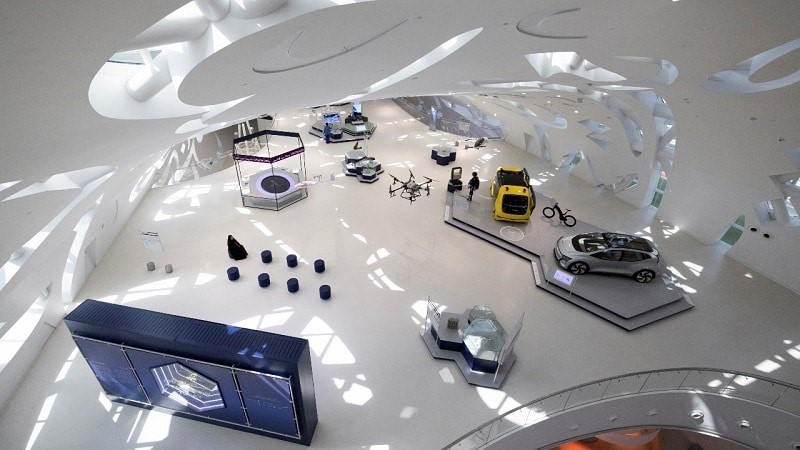
Features and Content of the Museum
The Museum of the Future in Dubai is an interactive space specifically designed to familiarize visitors with the future of technology, science, and social transformations. This museum not only serves as an educational and recreational venue but also provides a space for inspiration and reflection on the challenges and opportunities ahead for humanity. The museum is divided into several sections, each dedicated to a specific aspect of the future:
- The Future of Humans and Society
This section of the museum explores fundamental changes in human life in the future. How will daily life be affected by new technologies? With advancements such as Artificial Intelligence (AI), Virtual Reality (VR), and the Internet of Things (IoT), human life and social interactions will undergo significant transformations. In this section, visitors can experience the future, witnessing how these technologies will change social relationships, education, work, and private life.
This section may also explore how humans will interact with robots, automated systems, and digital assistants, showcasing a future where humans and technology evolve together.
- Innovative Technologies
In this section, visitors are introduced to the latest innovations and scientific achievements in various fields such as renewable energy, medicine, robotics, and transportation. The focus is on a future where modern technologies are capable of solving global challenges. For example:
- Renewable Energy: How sustainable energy sources like solar, wind, and hydrogen can replace fossil fuels and help combat climate change.
- Medicine: Advancements in medicine and new treatments, such as genetic therapies and personalized medicine, which help humans live longer and healthier lives.
- Robotics and Automation: The impact of robots and automation technologies on various industries and everyday life.
- Transportation: Innovations such as self-driving cars, flying vehicles, and smart transportation systems that will make travel faster, safer, and more affordable in the future.
- The Future of Earth
This section of the museum focuses on environmental challenges and climate change that humanity will face in the future. How can we protect the Earth from environmental crises and manage natural resources sustainably? Visitors can explore innovative ideas and solutions proposed to address issues such as global warming, environmental pollution, and the depletion of natural resources. This section examines strategies to improve human life and protect the planet.
Specifically, technologies like sustainable agriculture, ocean conservation, circular economies, and green technologies to address environmental crises may be featured in this section.
- The Future of Space
This section explores the field of space and astronomy, offering visitors the opportunity to immerse themselves in the wonders of space. How might humans leave Earth in the future and live on other planets or space stations? In this section, visitors will learn about space technology advancements, how space travel to other planets may occur, and future projects for space exploration, such as settling on the Moon and Mars.
This section particularly addresses the concept of space colonization and how people might live in environments outside Earth using modern technologies, such as commercial space travel, establishing human settlements on the Moon and Mars, and even exploring other galaxies.
The Museum of the Future in Dubai is not only designed as a cultural and recreational center but also serves as an educational and inspirational tool, acquainting visitors with the challenges and opportunities humanity will face in the future. The museum delves into the future in various fields, including social, environmental, technological, and space-related aspects, offering visitors an exciting vision of an innovative and advanced future.
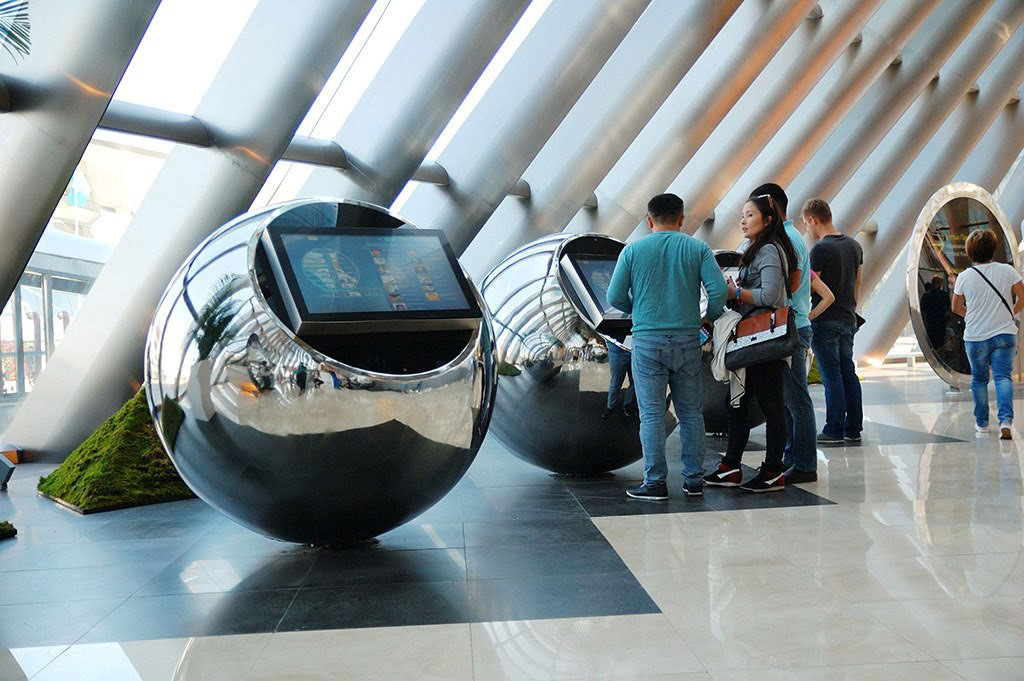
Interactive and Digital Experiences
The Museum of the Future in Dubai specifically focuses on interactive and digital experiences to introduce visitors to the future in a novel and engaging way. By utilizing advanced technologies such as Virtual Reality (VR), Augmented Reality (AR), and other digital technologies, this museum becomes a multisensory experience that not only educates but also provides moments of excitement and entertainment for visitors.
- Virtual Reality (VR)
Virtual Reality (VR) is one of the primary tools at the Museum of the Future, allowing visitors to immerse themselves in a virtual world and engage in interactive experiences. Through VR headsets, visitors can travel to different places and times. For example, they can step into a future world filled with cutting-edge technologies, journey to space, visit other planets, or interact with complex scientific concepts like Artificial Intelligence, robots, and space exploration.
Specifically, the museum may offer experiences such as traveling through space, envisioning smart cities of the future, or meeting future humans, enabling visitors to experience the virtual world in a vivid and detailed way.
- Augmented Reality (AR)
In addition to VR, Augmented Reality (AR) plays a significant role at the Museum of the Future. AR allows visitors to use smartphones or special tablets to view digital information and 3D animations overlaid onto the physical environment. In other words, visitors can blend the real world with digital layers, receiving new insights and experiences that were previously unimaginable.
For example, visitors can touch specific objects inside the museum and view them from different angles, or learn more about each exhibit’s history and its impact on the future.
- Audio-Visual Displays
To enhance the interactive experience, audio-visual displays are another key element of the Museum of the Future. These displays present information to visitors in an engaging and informative way, telling stories of the future through moving images, animations, complex graphics, and ambient sounds.
These multimedia presentations are particularly effective in explaining complex concepts, such as climate change, the progression of new technologies, or social transformations in the future. Each display is usually accompanied by captivating sounds and dynamic visuals, making visitors feel as if they are inside a futuristic world.
- Other Interactive Experiences
In addition to VR and AR, the Museum of the Future includes environmental simulations, interactive devices, and digital exhibits that allow visitors to directly engage with various technologies and concepts. For instance, visitors can interact with robots, smart devices, and automated systems from the future using interactive technologies.
These sections are designed in a way that encourages visitors to take a more active role in exploring the future and make their own choices about which advanced technologies they wish to examine.
The Museum of the Future in Dubai, with its focus on interactive and digital experiences, not only enables visitors to learn about the world of tomorrow but also brings them closer to complex scientific and technological concepts. The use of Virtual Reality (VR) and Augmented Reality (AR), along with captivating audio-visual displays, provides visitors with a memorable and educational experience, turning the exploration of the future into an exciting and unforgettable journey.
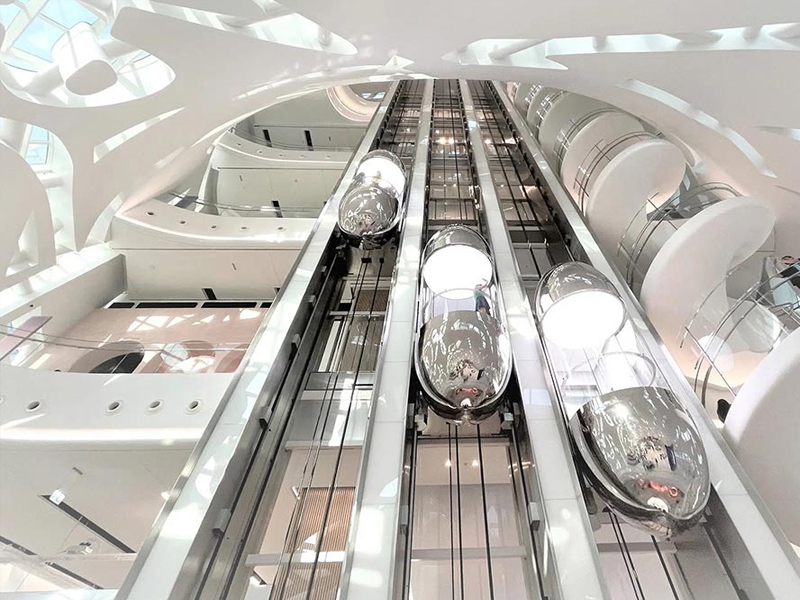
Goals of the Museum of the Future
The Museum of the Future in Dubai plays a key role in shaping the views and ideas of future generations by raising public awareness about advanced technologies and future challenges. This museum is not only a cultural and educational center but also serves as a catalyst for innovation and scientific research in the Middle East. The primary goal of the museum is to provide not only information but also a space for reflection and brainstorming about a better and more sustainable future.
- Raising Awareness of Advanced Technologies
The Museum of the Future in Dubai is designed as a specialized center for introducing cutting-edge technologies to the public. It gives visitors the opportunity to learn about emerging technologies still in their early stages of development, such as artificial intelligence, augmented and virtual reality, robotics, biotechnology, and renewable energy. The exhibits are designed to lead visitors to a deeper understanding of innovative technologies and show how they can shape the future. The museum helps people recognize the impact of these technologies on daily life and humanity’s future.
- Catalyst for Innovation and Research
The Museum of the Future serves as a catalyst for innovation and research in the Middle East. It provides researchers, scientists, engineers, and entrepreneurs with a unique platform to showcase scientific achievements and modern technologies, offering a research and experimental space for international projects. In addition, the museum functions as an innovative space and idea incubator where individuals can test scientific and technological projects and help realize new ideas.
The museum, especially for startups and emerging companies, offers an opportunity to display their technologies and ideas, contributing to the growth of the technology industry in the Middle East. The collaboration between researchers and experts accelerates the process of innovation and the spread of advanced technologies.
- Inspiring Future Generations
One of the main goals of the Museum of the Future is to inspire future generations to participate in building a better and more sustainable world. The museum not only provides information about technological advancements but also challenges visitors to play a role in solving major human problems, such as climate change, poverty, public health, and global crises.
By introducing innovative solutions in various fields, the museum encourages individuals to leverage the opportunities offered by technology and contribute to creating a sustainable and balanced future. With a focus on sustainable development, the museum shows future generations how they can use emerging technologies to address environmental and social crises, guiding the world toward a better future.
- Training Tomorrow’s Innovators
Through its programs, workshops, interactive exhibits, and digital experiences, the Museum of the Future strengthens scientific knowledge and innovation in young generations. These programs aim to cultivate a new generation of innovators and technology entrepreneurs who can bring positive changes in areas such as technology, the environment, and health.
- Attracting International Collaborations
In addition to its role as an educational and research center in the Middle East, the Museum of the Future offers an opportunity for international collaborations in various fields. Through partnerships with universities, research institutions, and global companies, the museum helps in the exchange of knowledge and technology and plays a role in the development of scientific and technological projects worldwide.
The Museum of the Future in Dubai, as an innovative and educational space, is designed not only to raise awareness and educate current generations but also to inspire people to think about the future and potential solutions to upcoming challenges. The museum strives to act as a catalyst for innovation and scientific research in the Middle East, motivating future generations to play a role in building a better, more advanced, and sustainable world.
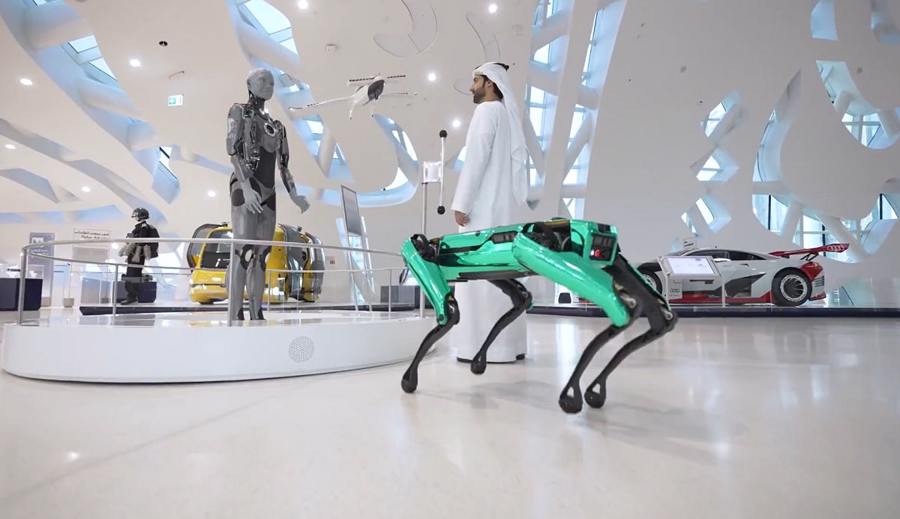
Awards and Recognition
The Museum of the Future has received numerous awards due to its creative design and unique structure. Notably, it has been recognized in international architecture and design competitions.
How to Visit the Museum
To visit the Museum of the Future, you can purchase tickets online. The museum also offers specialized and educational tours for groups and schools. The usual operating hours are from 10 AM to 6 PM, but these may vary on special occasions.
Role in the Development of Dubai
The Museum of the Future aligns with Dubai’s development strategies and its vision to become a global center for innovation and technology. It is recognized as a symbol of Dubai’s forward-thinking approach and investment in advanced technologies.
The Museum of the Future in Dubai is not only a unique tourist destination but also an educational and inspiring space, raising awareness about the challenges humanity will face in the future and potential solutions to those challenges.
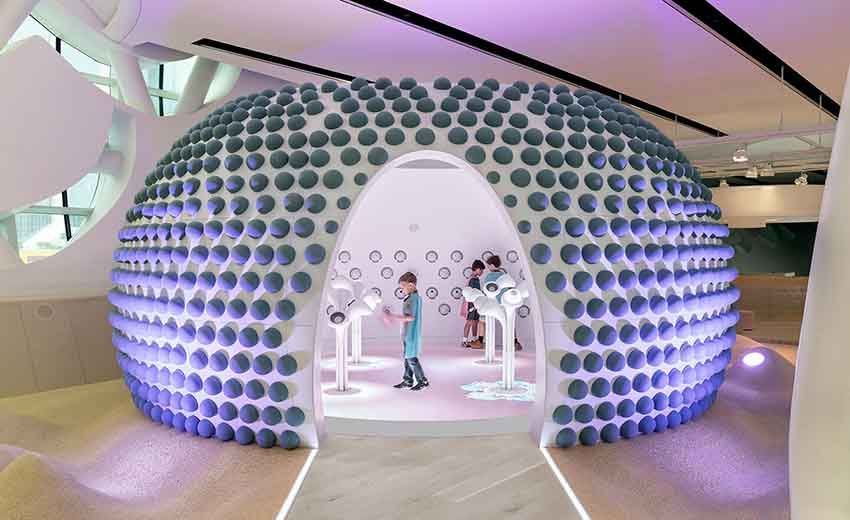
Dubai’s Museum of the Future is a globally renowned architectural masterpiece, designed by Killa Design. Its elliptical shape and central ring give it a distinctive appearance of a floating ring in the sky, symbolizing the future, technology, and innovation. The absence of columns creates spacious and flexible interiors, allowing visitors to immerse themselves in advanced technologies and experience the future firsthand. The museum’s structure is made of steel and glass, providing both strength and transparency. Recognized in international competitions, the Museum of the Future reflects Dubai’s commitment to innovation and technology, serving as a symbol of the city’s vision for the future.
The Museum of the Future in Dubai is an iconic architectural masterpiece created by Killa Design. Its elliptical shape and central ring give it a distinctive floating appearance in the sky, symbolizing the future, technology, and innovation. With its column-free design, the museum offers spacious and flexible interiors that allow visitors to fully immerse themselves in advanced technologies and experience the future firsthand. Constructed using steel and glass, the museum showcases both strength and transparency. Recognized in international competitions, the Museum of the Future represents Dubai’s steadfast commitment to innovation and technology, serving as a visionary symbol for the city’s future direction.
